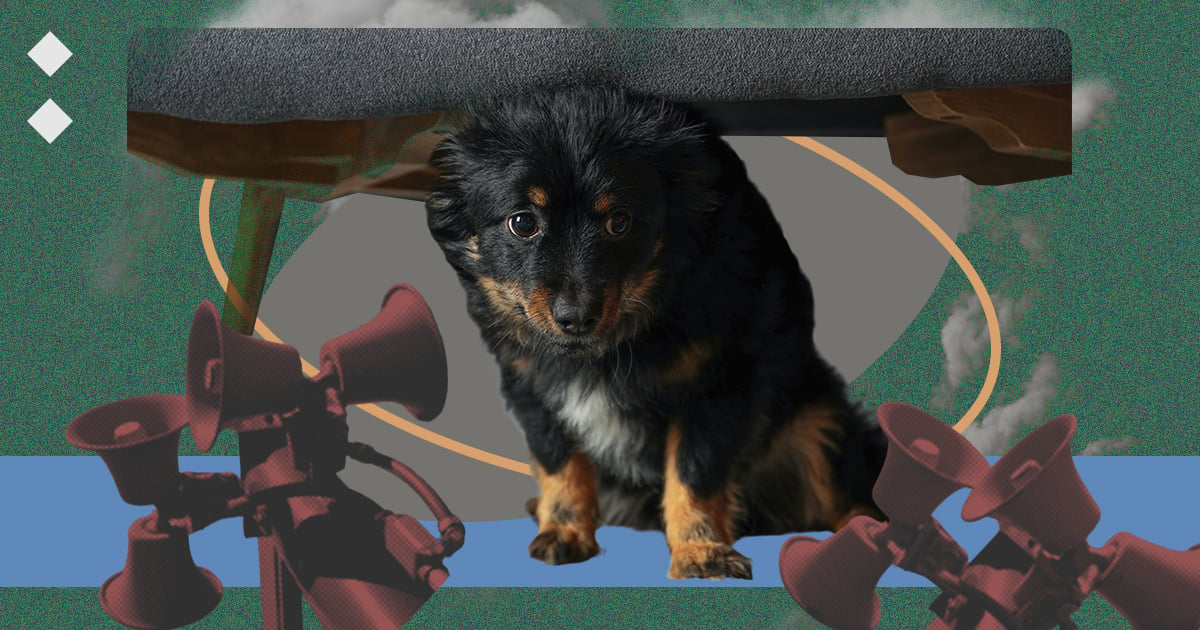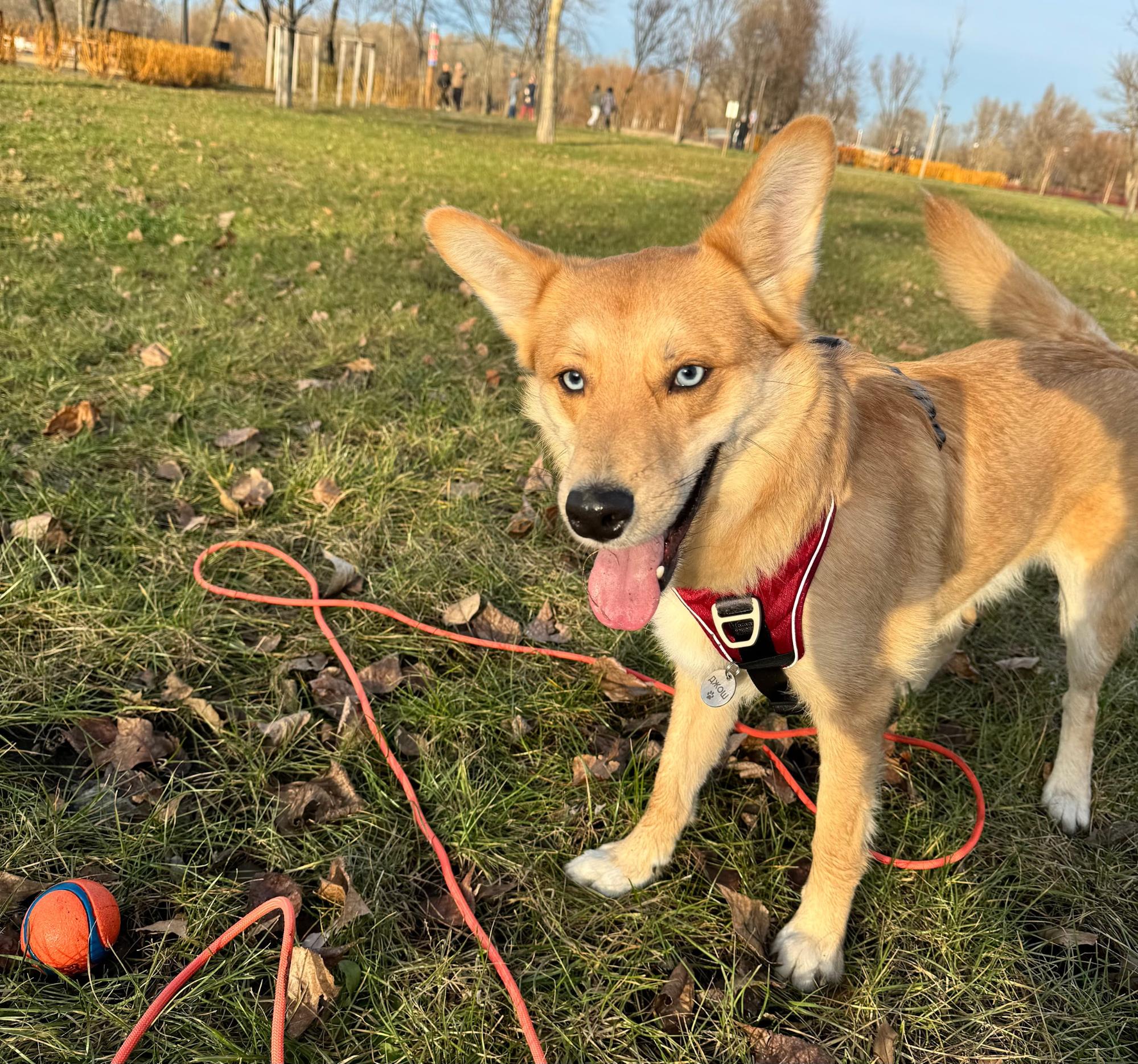Rubryka spoke with a veterinarian and a dog trainer to find out how to help your dog or cat if they’re afraid of loud noises. We also share helpful tips on how to assist your pets in coping with stress.


For Joshua, every walk feels like a test. The moment he hears a loud sound, even in the distance, he trembles and stubbornly pulls toward home. Sometimes, he forgets his fear, but the sound of an explosion, a gunshot, or even a roaring truck instantly brings it back, repeating the cycle.
Joshua is a war dog. Born in the Kyiv region two years ago, he spent his first year on the streets before ending up in a shelter. Maryna, who adopted him, believes he was constantly exposed to explosions during that time. Even in a loving home, the trauma lingers—he fears thunderstorms, reacts to air defense sirens and missile or drone strikes, and flinches at any loud noise.
Joshua is not the only such dog. War changes not only people, but also animals. How to help them? How to reduce fear and its negative impact on the animal's health? And what to do if your dog also started to be afraid?
Rubrнka talked to experts — veterinarian Viktoriia Sherstiuk and dog behavior specialist Daryna Vasylchuk — about the challenges of war for pets and ways to support four-legged friends.


Joshua on a walk. Photo courtesy of the dog's owner
Each animal is unique, making it impossible to predict how or when it will start reacting to war. Explosions and sirens can have lasting psychological effects, and while PTSD in animals remains understudied, their symptoms resemble those seen in humans—heightened anxiety and panic attacks.
Animals respond to loud sounds in different ways, but the most common reactions include:
Chronic stress is just as harmful to animals as it is to humans. Even after being relocated to safety, many continue to fear loud noises.
"Unfortunately, dogs form their own unique fear associations because you can't explain to them that missiles can strike at any moment. In practice, we often see cases where a dog becomes afraid to go outside during the day because an explosion that scared them happened in daylight—so now, they only feel safe in the dark," says dog trainer Daryna Vasylchuk.
She shares another example: one of her recent clients left their dog home alone when an air defense system activated nearby. Terrified by the noise, the dog began associating loneliness with fear. Since then, he has developed separation anxiety, howling and barking whenever left alone.
Daryna Vasylchuk with her dog. Photo courtesy of the expert's archive
Regular exposure to loud sounds can impact not only an animal's mental well-being but also its physical health. Veterinarian Viktoriia Sherstiuk notes that stress can trigger serious conditions such as thromboembolism, worsening heart disease, and urethral obstruction (acute urinary retention). Studies have shown that stress is a major factor in the development of cystitis in animals.
"This is a pressing issue, and addressing it requires a comprehensive approach—including more environmentally friendly pet care practices and, when necessary, the use of modern anti-anxiety medications," says Dr. Sherstiuk.
It's important to recognize that fear is not a behavioral problem but a natural response of the nervous system. An owner's role is not to force their pet to "overcome" fear but to help them manage it. With the right approach and proper methods, progress is always possible.
Sniffing mat. Photo from open sources
It's important to act proactively rather than wait for a dog to show signs of anxiety or nervousness. However, the approach depends on how manageable the animal remains in a state of panic.
In some cases, simple methods can help reduce anxiety and shift the pet's attention:
A dog's response to stress is also influenced by its owner's emotional state.
"Dogs are highly empathetic—they pick up on their owner's emotions. This is the most important factor to consider. If a person is panicking, yelling, or acting frantic, the dog will absorb that fear and create a negative association. This significantly increases the chances of panic in future stressful situations. That's why my first advice is always: find the safest possible place to go together before attempting any calming or distraction techniques," says Vasylchuk.
Make sure your dog has designated hiding spots at home for stressful situations. If none exist, create one. Never scold a dog for hiding in a closet or under furniture—on the contrary, encourage it as a safe space.
If loud noises occur during a walk:
However, if the stress level is too high, the dog may ignore these methods. Some pets may respond to a simple treat or a sip of water, while others may require more intensive care, such as distraction and physical comfort. In severe cases, consulting a behavioral veterinarian is recommended. They can prescribe sedatives or other aids, such as noise-reducing headphones for dogs.
Victoriia Sherstiuk examining an animal. Photo courtesy of the doctor's archive
"Light anti-stress medications such as Zylkene, Adaptil Calm, KalmVet, and Feliway for cats are the easiest to introduce. In Joshua's case, mentioned earlier, Phenibut—a calming drop for cats and dogs—could help (dosage: 2 drops (10 mg) per 1 kg of weight, twice a day). Sileo gel has also proven effective for noise phobias and fear in dogs. However, medications should never be purchased based solely on the owner's opinion—a veterinarian must determine the appropriate treatment and dosage," says Sherstiuk.
Do not expect instant results from medication or behavioral exercises—managing anxiety requires a comprehensive approach and takes time.
Tip: Attach an ID tag to your dog's collar or harness. If a dog is frightened by explosions, it may break free and get lost during a walk. A tag with the owner's phone number significantly increases the chances of finding and safely returning your pet.
Dog refuses food. Photo from open sources
If an animal is stressed and refuses to eat or drink, that's normal—do not force it, scold it, or push its face into the bowl, as this will only increase anxiety. Instead, give your pet time to calm down.
"If the animal is in its own quiet space, let it stay there. Don't try to remove it or prevent it from hiding—at moments like these, stress can even lead to aggression," advises Vasylchuk.
However, if your pet hasn't eaten for more than 12 hours, it's important to visit a veterinarian. The doctor will assess the situation, as stress can sometimes trigger underlying health issues.
The following signs indicate that your animal may need professional help:
"Currently, regular visits are prompted by excessive excitement, symptoms like 'catching flies' while resting, and night barking. In cats, common signs include hiding for long periods, minimal movement, and unusual aggression. Treatment always begins with gathering information about the animal—this involves a conversation with the owner, without unnecessary tests. Only after analyzing the situation do we prescribe anti-anxiety medications or, for example, recommend working with a zoopsychologist. In my opinion, offering a universal pill for everyone is a mistake," says Sherstiuk.
Japanese Chin evacuated from Donetsk region. Photo: UAnimals
It's important to understand that animals evacuated from stressful situations inevitably experience trauma and will require time to adapt. They may never fully adjust, and that doesn't mean they are "wrong," bad, or aggressive—it simply means their reactions may be more intense due to the stress they've endured.
The key is recognizing that these animals need extra time and attention from their owners. Here's what you can do to help them:
A dog should have a place where it can rest peacefully. Photo from open sources
Animals, especially dogs and cats, are highly attached to routines and rituals. During significant life changes—such as moving or changes in family composition—it's crucial to maintain a consistent daily routine, including feeding and walking times. Keeping the animal's life as familiar as possible will help them adjust more easily to new circumstances.
If you've moved and are starting a calmer life, consider the following strategies:
Additionally, it's a good idea to find safe areas for walks, such as enclosed spaces, and get acquainted with your local veterinarian so you know where to seek help if needed. Gradually, you can also look for new friends to walk with your dog to enrich their social experience.
Many pet owners are switching their dogs and cats to different food due to the war. It's important to make this transition correctly to avoid harming the animal.
With so many food options on the market, Sherstiuk recommends the following approach for a smooth transition:
Власним досвідом та практичними порадами з “Рубрикою” поділилася корекційна педагогиня, психотерапевтка, мама дітей з розладами… Читати більше
Вже під час війни Україна використовує штучний інтелект (ШІ) як потужний інструмент для відбудови та… Читати більше
У Житомирській обласній філармонії ім. С. Ріхтера пів року працює студія PНIL-ART. Тут професійні артисти… Читати більше
In our conversation, Dmytro Syrykh discusses the work of Ukraine's Energy Efficiency Fund amid the… Читати більше
“Рубрика” розповідає про рішення з Закарпаття, що стимулює донати та волонтерську діяльність. Читати більше
On January 20, 2025, Donald Trump was sworn in as the President of the United… Читати більше
Цей сайт використовує Cookies.